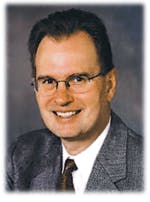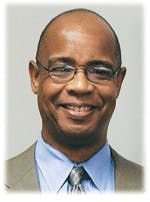Anne Pontius, MBA, CMPE, MT(ASCP), a member of MLOs editorial advisory board, is president of Laboratory Compliance Consultants in Raleigh, NC. She organized and chaired this years CLMA Executive Track panel, co-sponsored by Medical Laboratory Observer (MLO), Expert Opinion: Key Trends in the Clinical Laboratory Industry. The panel discussion was based onMLOs executive interview series.Representing major players in the clinical diagnostics industry, six industry leaders addressed the impact of genomics and proteomics, the shortage of trained personnel, point-of-care testing, the aging population, interaction with customers, community outreach programs, reimbursements and new technology. Following their joint presentation, the panelists hosted a highly informative question-and-answer forum on the challenges that face the industry for the next five years and how those can be met.Here are brief synopses of comments by these distinguished guest panelists, in order of appearance:
Doug
Harris, vice president of marketing and sales for North America, joined Greiner Bio-One in 1997 with the responsibility of building its American manufacturing plant.
(Interview published April 2003)Harris commenced the session with his observations on the topic of sampling, pointing out that decentralization of samples results in less management. He noted that laboratorians now get quicker and better samples, and he highlighted current sampling trends, such as smaller sample sizes, more sensitive instrumentation and improved sampling hardware. He stressed, however, that the industry must continue to strive for ongoing improvements in sampling processes. Along with other panelists, he also commented later on his companys community efforts to improve recruiting for the clinical laboratory field.
S. Wayne Kay is Quidel Corp.s president and COO. He earned his BS in Business Administration from the University of San Francisco and his MBA from Pepperdine University.
(Interview published February 2003)Kays comments on
in vitro diagnostics included four basic criteria for point-of-care products: rapidity, accuracy, cost-effectiveness and simplicity. He pointed out that a product should be so simple that when put in the least technically competent hands, the results will always be consistent. As an example, Kay explained a moderately complex test that five years ago took seven reagents, 15 steps and 20 minutes for results. Now, an improved Quidel solution takes one reagent, three steps and 10 minutes for results. Market segments grow where there is a need, he said.
in vitro diagnostics included four basic criteria for point-of-care products: rapidity, accuracy, cost-effectiveness and simplicity. He pointed out that a product should be so simple that when put in the least technically competent hands, the results will always be consistent. As an example, Kay explained a moderately complex test that five years ago took seven reagents, 15 steps and 20 minutes for results. Now, an improved Quidel solution takes one reagent, three steps and 10 minutes for results. Market segments grow where there is a need, he said.
Randy Daniel is president of Dade Behring North America Customer Management. A microbiologist by education, he is a registered medical technologist with the American Society of Clinical Pathology.
(Interview published January 2003)Daniel covered the five most consistent factors that face clinical laboratories today: pressure to reduce costs; need to improve turnaround time; shortage of medical technologists; compliance with outreach (Medicare, and now provider rules); and quality improvement (achieving positive patient IDs/reducing label errors). Dade Behring utilizes its healthcare consulting team to focus on solutions, creating a customized approach for each client. Its team provides support in instrument platform consolidation. The ability to consolidate three to four instruments workload into one improves medical technologists efficiency and eliminates cost of multiple instrument-system capital, maintenance and calibration. Consolidation improves service to laboratories ultimate customer the patient by looking for solutions to help shorten turnaround time on test results. Its consulting team has cut turnaround times by 30 to 45 minutes.
Cathy
Shea, vice president, sales and marketing, Vacutainer Systems, BD Preanalytical Solutions. She represented BD for William A. Kozy, president of BDs Clinical Laboratory Solutions, who was interviewed in May 2003.Sheas topic addressed the Six Sigma processes in place at BD, which ensure customer needs are met by identifying, containing and controlling variables that affect product performance. Controlling process for forecasting in manufacturing can help avoid the back-order setbacks. Meeting exacting Six Sigma quality levels can avert rework costs, inspection costs, recalls, customer complaints, assaults on reputation and declines in employee morale. Industry experts estimate that the cost of poor quality can contribute from 15% to 30% of the manufacturing cost of a product. Six Sigma enables BD to maintain a level of price stability and product quality over time. Shea pointed out that the current industry standard accepts and works toward Four Sigma which allows 6,210 defects for every one million units manufactured. Six Sigma levels of quality are considered to be world class, allowing no more than 3.4 defects in one million units.
Herb Steward is senior vice president of Commercial Operations North America for bioMrieux Inc., handling sales, marketing, service and sales administration. He has 23 years experience in the diagnostic industry, and holds an MBA and a bachelors in marketing management from Webster University in St. Louis, MO. Steward represented Phillipe Sans, president and CEO of bioMrieux North America, who was interviewed in March 2003.Steward identified two huge trends that impact the laboratory: the aging population in 2004, 40% of U.S. citizens will be approaching age 65 and the cost of healthcare in the United States. He predicts that healthcare costs will consume 16% of the U.S. gross domestic product in five years, putting it behind the 8% to 10% reflected globally. Efficiently and productively managing costs will be crucial. The future role of diagnostics, he said, is to look at the impact of new products on the clinical lab, recognizing that information needs to be packaged so that clinicians can maximize a positive conclusion for their patients. Molecular diagnostics, he stated, is moving from managing
illness to managing disease to managing wellness, and will become the most valuable part of a hospital.
illness to managing disease to managing wellness, and will become the most valuable part of a hospital.
Ronald L.
Weiss, MD, MBA, is a senior vice president and the director of Business Development at ARUP, and a professor of pathology at the University of Utah School of Medicine, board-certified in anatomic and clinical pathology, microbiology and hematology.
(Interview published November 2002).Dr. Weiss speaking on the subject of reference laboratories stated that they need to act responsibly to develop products that are clinically useful, not just profitable. He shared his insights on the expensive lab tests and technology available today for combating AIDS, SARS and bioterrorism, and highlighted the dramatic changes in technology. With the explosion of molecular tests on the market, he said, the
promise of genetics can be the problem of genetics. In regard to the latter, he gave example of some families choosing to abort babies based on such tests, and many insurers are not covering expensive genetic tests.
August 2003: Vol. 35, No. 8© 2003 Nelson Publishing, Inc. All rights reserved.
promise of genetics can be the problem of genetics. In regard to the latter, he gave example of some families choosing to abort babies based on such tests, and many insurers are not covering expensive genetic tests.
August 2003: Vol. 35, No. 8© 2003 Nelson Publishing, Inc. All rights reserved.
About the Author
Sign up for our eNewsletters
Get the latest news and updates








